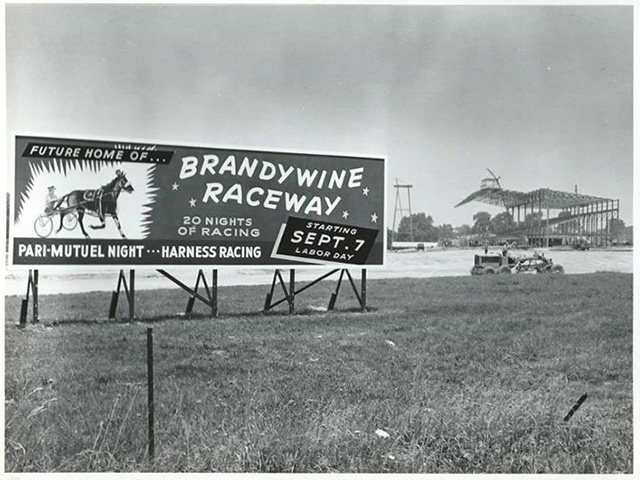On Friday, September 8, Harrah’s Philadelphia will honour the former now-legendary Brandywine Raceway, which played host to races in nearby Wilmington, Del. from 1952 until its closing, which came after the 1989 season.
Many of the top horses and horsemen of the last half of the 20th century – headed by immortals Billy Haughton, Stanley Dancer and Joe O’Brien – competed at the track
Nathan Miller headed the successful drive for a harness track serving the Delaware, southeastern Pennsylvania and southern New Jersey areas. Headed by Miller’s son, Howard Miller, Brandywine was an immediate success. In the mid-1960s, entrepreneur John Rollins purchased the operation and installed Hap Hansen as raceway director.

The popular Delaware raceway quickly emerged as one of the top facilities in the Standardbred industry with the talented Bill Davis as track superintendent.
Jim Lynch was the track’s first director of racing, while the famed Milt Taylor was the track’s first presiding judge – both of whom have since been elected to harness racing’s hall of fame. Race secretaries Joe DeFrank and Ted Leonard were also voted into the hall of fame. Other former Brandywine employees that are in the Harness Racing Hall of Fame Communicators section include announcer Roy Shudt, PR Directors Col. Dave Herman and Marv Bachrad, along with Moira Sullivan Fanning, Jerry Connors and Steve Wolf. Two newspaper writers that covered Brandywine on a daily basis, Izzy Katzman of the Wilmington News Journal and Nick Saponara, a Philadelphia Bulletin handicapper, also are in the Communicator’s Corner.
In 1960, Brandywine converted its racetrack from a half-mile course to a five-eighth mile oval and added a new clubhouse that featured a window that could become open-air when weather and temperatures permitted.
Brandywine closed in 1989. There was a slots bill that would have passed into law without a signature, but it was vetoed the last minute by then-governor Mike Castle. In January 1990, a strong effort to override the veto failed by one vote. A short time later, the Brandywine Raceway property became a sprawling mall.
In its heyday, annually in early June, Brandywine was a leadoff track for Grand Circuit racing. The Battle of the Brandywine was the first major three-year-old pace each season. The Tom Hal Colt Pace and Nancy Hanks Filly Trot were major freshman events. Later in the season, the Marques de Lafayette Trot and Adios Harry Pace were top older races. During its existence, 1953-1998, annually, the top colts, fillies and older horses raced at the track.
One of the memorable highlights at the track feature the top two pacers in the land when Nansemond overtook Albatross, who made an early misstep on the backstretch to score another upset of the legendary pacer whom he had beaten in two heats of Little Brown Jug.
Hall of Famer Herve Filion was part of two memorable events. In 1970, Filion who trained and drove five horses, all from his stable, to sub-2:00 victories, a remarkable feat, especially at the time. Filion also drove unsung Icarus Lobell between horses in deep stretch to upset No Nukes in the Battle of the Brandywine, also in the early 1970s.
Even earlier, Su Mac Lad, driven by Stanley Dancer, came from behind to beat Speedy Scot and Speedy Count in an all-star free-for-all trot. The event was the first of the year and last race for previous season’s Three-Year-Old of the Year, Ayres, who then was retired to a Hanover Shoe Farm stallion.
Eddie Davis came into prominence in the early 1970s after Filion moved to New York. Davis became the all-time winningest driver at Delaware Valley tracks.
At the time of its closing after the 1989 campaign, Brandywine had the most 2:00 miles at a five-eighths-mile racetrack.
The track was an innovator of a number of special events for fans created by PR Director, Col. Dave Herman. ‘Christmas In July’ drew its largest crowd of around 25,000 in the late 1960s. Bret Hanover attempted a world record and attracted nearly 20,000 fans to the track. For several seasons, a well-supported event featuring several races between ‘The Dancers and Filions,’ a father-and-son rivalry competition, Camel and Ostrich races, and big band and top singers were other promotions.
Brandywine was the first major track to race Sunday cards. It was also one of first to add exacta and trifecta wagering and was one of the first to offer free admission. Electronic Race Patrol provided the finest CCTV and sound ever in the sport. It was first to offer split screen and colour TV to fans. Between races, Brandywine featured a great number of interviews and vignettes to inform its patrons. Its popular dining room featured a rising window that opened when the temperature permitted. The track also boasted the best horsemen’s kitchen – just ask anyone who was stabled there.
Many of the top figures from the sports and entertainment world came to the track. Pete Rose, Julius Erving, Muhammad Ali, NFL, NBA, NHL and MLB players were often seen in presentations at the track.
Brandywine was considered as the nicest, best kept, best managed racetrack imaginable. The racetrack surrounded two tall water towers located in a centrefield lake. Fans would be treated to glorious sunsets as the races began during the summer months. Across a parking lot, the racing office, the ‘White House’ publicity office where hospitality was on after the races nightly, fronted the horsemen’s kitchen and snack bar.
Superintendent Bill Davis designed a remarkable setup for its horse barns which allowing air flow for horse. Brandywine also featured modern grooms quarters accommodations caretakers with a cushioned bed and air conditioning.
Even today, horsemen and fans continue to remember the ‘gone but not forgotten’ great days of Brandywine Raceway.
(Harrah’s Philadelphia)

